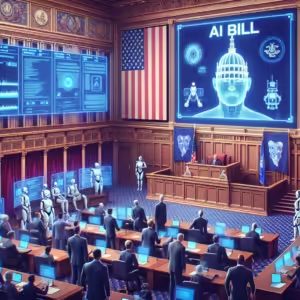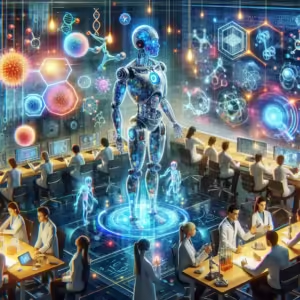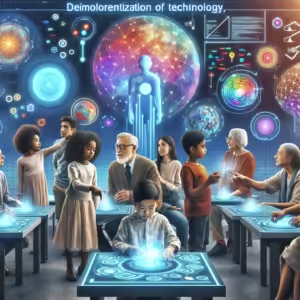Revolutionizing American Manufacturing: SoftBank’s Bold Move
SoftBank, the Japanese multinational conglomerate, has announced an ambitious plan to invest $1 trillion in establishing AI-powered robot factories in the United States. This monumental investment signals a game-changing evolution in American manufacturing, emphasizing innovation and technological advancement.
The Vision Behind SoftBank’s Investment
SoftBank’s commitment to AI and robotics is not new. The company’s strategic focus has long been aligned with cutting-edge technology, particularly in AI development. Here’s why this $1 trillion investment is significant:
– **Transforming Manufacturing**: By harnessing AI, these factories propose an overhaul of traditional manufacturing processes, aiming for increased productivity and efficiency.
– **Sustainability**: AI technology promises to reduce waste and energy consumption, aligning with global sustainability objectives.
– **Job Creation**: While automation is often associated with job losses, SoftBank projects the creation of high-skilled jobs related to AI development and maintenance.
The decision to invest on this scale within the US underscores SoftBank’s confidence in the American market as a frontier for technological development.
Strategic Locations and Infrastructure Development
Identifying strategic locations for these factories is crucial for logistical and economic reasons. Potential factors aiding these decisions include:
– **Proximity to Tech Hubs**: Cities with existing tech ecosystems, such as Silicon Valley or Austin, could serve as ideal locations due to their robust infrastructure and talent pool.
– **Economic Incentives**: States offering favorable tax conditions and economic incentives will likely be in the running for hosting these state-of-the-art facilities.
– **Accessibility to Resources**: Areas rich in natural and human resources will aid in seamless operations and growth.
Infrastructure Requirements
To support these factories, substantial infrastructure investments are necessary:
– **Energy Grids**: Enhanced electric grids will be essential to support the anticipated power demands.
– **Transport Networks**: Efficient transportation systems will ensure raw materials and finished goods are moved swiftly.
– **Telecommunications**: High-speed internet and robust telecommunications networks are non-negotiable to facilitate seamless AI operations.
The Role of AI in Manufacturing Innovation
AI technologies are set to be the backbone of these robot factories, revolutionizing how production processes are conducted. Here are key technological advancements to anticipate:
– **Automation of Repetitive Tasks**: AI will boost productivity by handling mundane tasks, allowing human workers to focus on complex and creative roles.
– **Predictive Maintenance**: AI systems can predict equipment failures before they happen, minimizing downtime and enhancing efficiency.
– **Real-time Analytics and Monitoring**: Through AI-driven analytics, factories will have the capability to optimize operations in real-time, ensuring peak performance at all times.
AI innovation will likely spur further research and development, encouraging other companies to adopt similar technologies and accelerate the growth of AI-integrated manufacturing.
Economic and Social Impacts
SoftBank’s investment brings profound economic and social implications, reshaping both the industry and society at large.
Economic Growth
The economic impact of such an investment is expected to be multifaceted:
– **Boost to GDP**: The anticipated increase in productivity and innovation could significantly contribute to the national GDP.
– **Increased Competitiveness**: American manufacturing’s competitiveness on the global stage will improve, attracting more foreign investments.
– **Small Business Opportunities**: Smaller companies could benefit as supply chains expand and new market opportunities arise.
Social Implications
The introduction of AI-powered factories doesn’t just touch on economic dimensions; it brings notable social changes:
– **Education and Skills Development**: A demand for skilled labor in AI will spur educational institutions to evolve their curricula, emphasizing STEM education and vocational training.
– **Changing Workforce Dynamics**: As AI handles more tasks, workers will need to adapt to new roles focused on machine collaboration and technology management.
Challenges and Considerations
While the advantages are numerous, several challenges need to be addressed to fully realize the potential of SoftBank’s investment:
– **Ethical Concerns**: Widespread automation raises ethical questions regarding data privacy and AI control.
– **Regulatory Hurdles**: Navigating the legislative landscape will be critical for ensuring compliance with national and international regulations.
– **Public Perception**: There may be public apprehension about job displacement and loss of craftsmanship, which companies will need to address through strategic communication and education efforts.
Looking Towards the Future
SoftBank’s investment sets a precedent for the future of manufacturing and AI integration. The success of this initiative will likely encourage similar investments from other global giants, further pushing the boundaries of technological innovation.
The coming years will reveal the full impact of this investment, potentially ushering in a new era of manufacturing efficiency and economic prosperity in the United States. As technology continues to evolve, the strategic implementation of AI will remain at the forefront of transformative change across industries. This monumental investment paves the way for a future where the synergy between human intelligence and machine precision drives unparalleled advancements in manufacturing.








